Hawaii is known for its tropical beaches overlooking the amazing blue North Pacific Ocean. So, when you think of visiting Hawaii for fishing, you often don’t think of freshwater fishing. Anglers looking for great freshwater fishing in Hawaii will be pleasantly surprised by the abundance of locations available.
The state has numerous islands with small lakes, ponds, and reservoirs, all containing freshwater fish. While the locations are limited to a few public fishing areas, it’s still a fun experience to have if you’re looking to wrangle a few fish unique to the islands.
So, if you’re curious about the best freshwater fishing in Hawaii, don’t worry! Here is what you can expect at the best freshwater fishing in Hawaii and what fish types to expect.
1. Koke’e Public Fishing Area
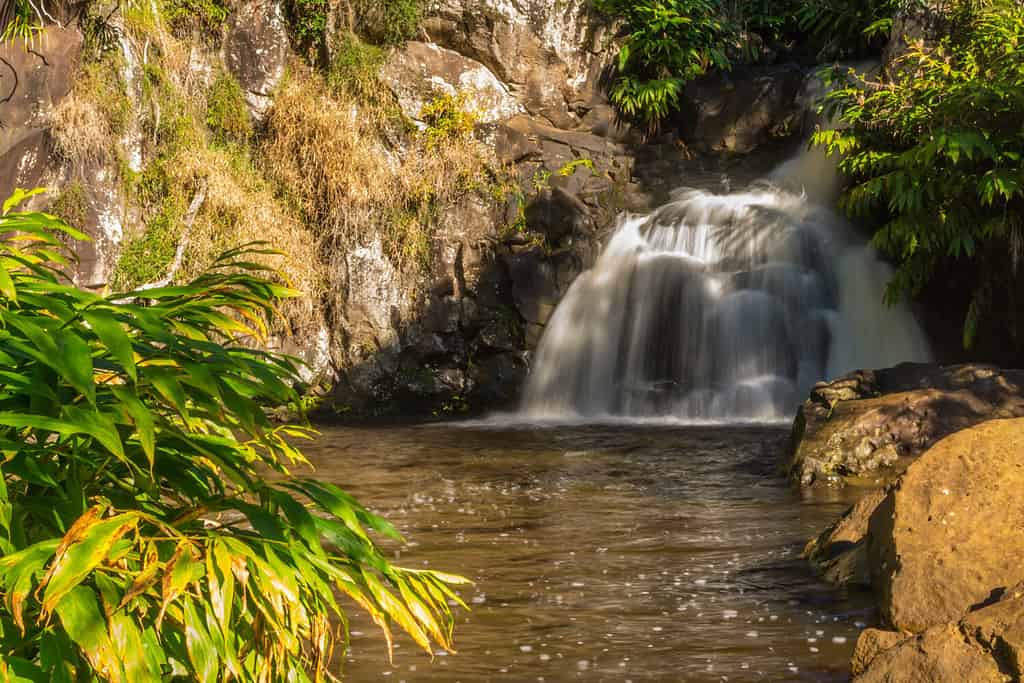
Koke’e has public fishing spots dedicated to the public.
©Ty Shitanaka/Shutterstock.com
Koke’e is a public fishing area designated for specific streams, reservoirs, and ditches in Koke’e State Park. There aren’t many freshwater locations, but Koke’e has a few streams and ponds where you can fish spread throughout the state park. Anglers tend to come to this location for one specific reason, and that’s because it’s one of the only locations in Hawaii where you can catch trout.
Koke’E Fish Species
Fishing at Koke’e can get you a few types of fish, but the most well-known is the rainbow trout. While the species are not native to Hawaii, the fish can adapt to different environments. The species was introduced to Hawaii in the early 1900s and has since acclimated to the climate.
Hawaiians come specifically to Koke’e to catch rainbow trout due to the species’ beautiful multi-hued coloration that mimics a rainbow. Their scales are blue, green, yellow, silver, and white and glisten in the sunlight. Not only are their looks stunning, but rainbow trout also make delicious dishes that have a mild fish taste.
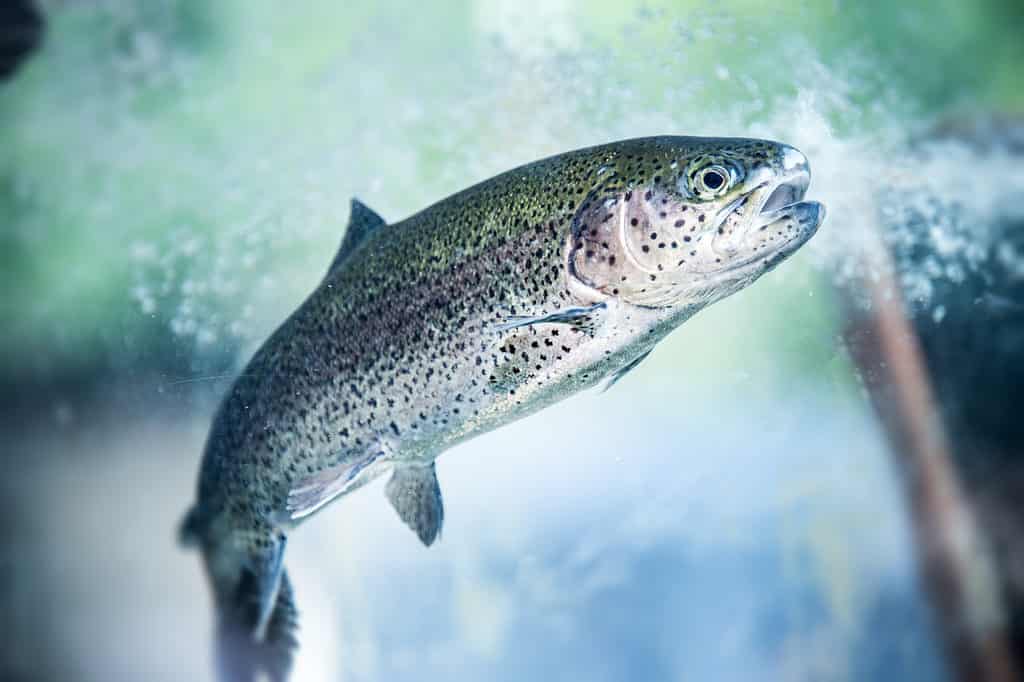
A rainbow trout is most commonly found in Koke’e Reservoir.
©iStock.com/Max2611
Finishing Limitations
Rainbow trout fishing is only available at specific seasons each year, and you can read the announcement by the Department on January 1st. However, they have strict guidelines on what you can or can’t do while fishing. You won’t be able to fish for any rainbow trout except as permitted, use corn as bait, or use treble hooks or more than one hook.
In addition, you can’t use nets, spears, chemicals, or other illegal fishing tools. Hawaii prizes itself on its nature reserves, and the state park takes violations very seriously. Lastly, you can’t damage public property, pollute streams, or fish in prohibited zones.
Licensing
All anglers wishing to fish at this location need a Freshwater Game Fishing License. The fees vary each year and apply to anyone looking to fish freshwater game fish. You can purchase a license online, in person, or from an authorized agent. The licenses are provided by The Division of Aquatic Resources for Hawaii.
Accommodations
The best way to catch fish early in the morning is to take advantage of the state park’s campsites. Here, you can camp for $20 per night if you’re a resident or $30 per night for non-residents. You must have a permit to camp, but you can easily make a reservation online. The freshwater fishing season is very popular, so you will need to make an early reservation.
2. Wahiawa Reservoir (Lake Wilson)

Peacock bass
can be found at Lake Wilson (Wahiawa Reservoir).
©Kwanza Henderson/Shutterstock.com
Lake Wilson, known as Wahiawa Reservoir, is one of Hawaii’s freshwater fishing areas. The small lake features more than 400 acres of open water, with amazing freshwater fishing. All Hawaii anglers come here because it’s the only place you can naturally catch freshwater fish.
Wahiawa Fish Species
Wahiawa Reservoir is home to a few different types of fish species. The species are in the area’s lakes, streams, and ponds. Here is a short description of each type of fish.
Peacock Bass
Peacock bass, also known as tucunaré, originated in South America. However, they were later introduced to Hawaii in the 1950s. They would mainly help control tilapia populations, which were becoming an ecological issue then. Despite their use for that small time period, the species is now abundant in Hawaii and Kauai lakes and streams.
The peacock bass is a member of the cichlid and tilapia family and has some distinctive features. Its large mouth, elongated body, and deep notch are located between the first and second dorsal fins. The species will put up a fight, which makes them challenging prey for anglers. They also make a delicious catch!
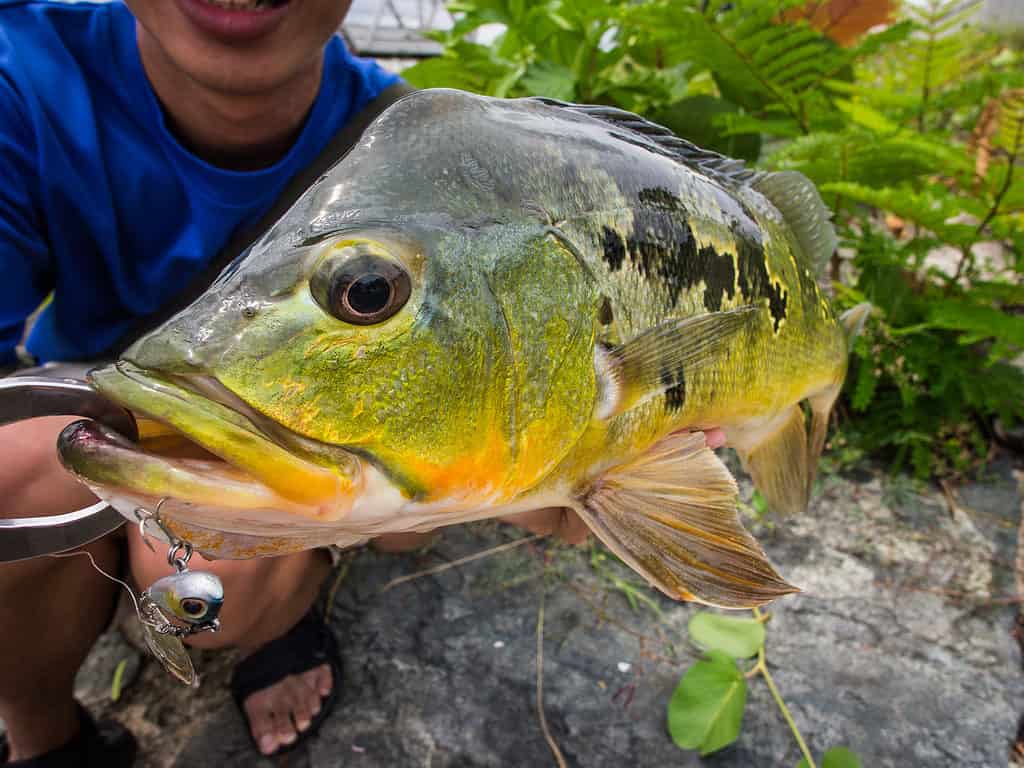
Peacock bass can grow to extreme lengths.
©Matthew Seah/Shutterstock.com
Red Devil
The red devil is an invasive exotic fish brought to Hawaii and Puerto Rico. They are one of the world’s most aggressive freshwater fish. If you’re up for a challenge, then you’ll enjoy angling this fish. The biggest one on the record caught at Lake Wilson was 1.16 pounds in 2007.
You can tell that you’ve spotted a red devil due to its bright vibrant color, which is hard to miss. The species boast bright shades of red, orange, and yellow scaling. On top of that, their bodies are long with a pronounced forehead and a large mouth. It is very hard to miss one of these in the bright Hawaiian waters.
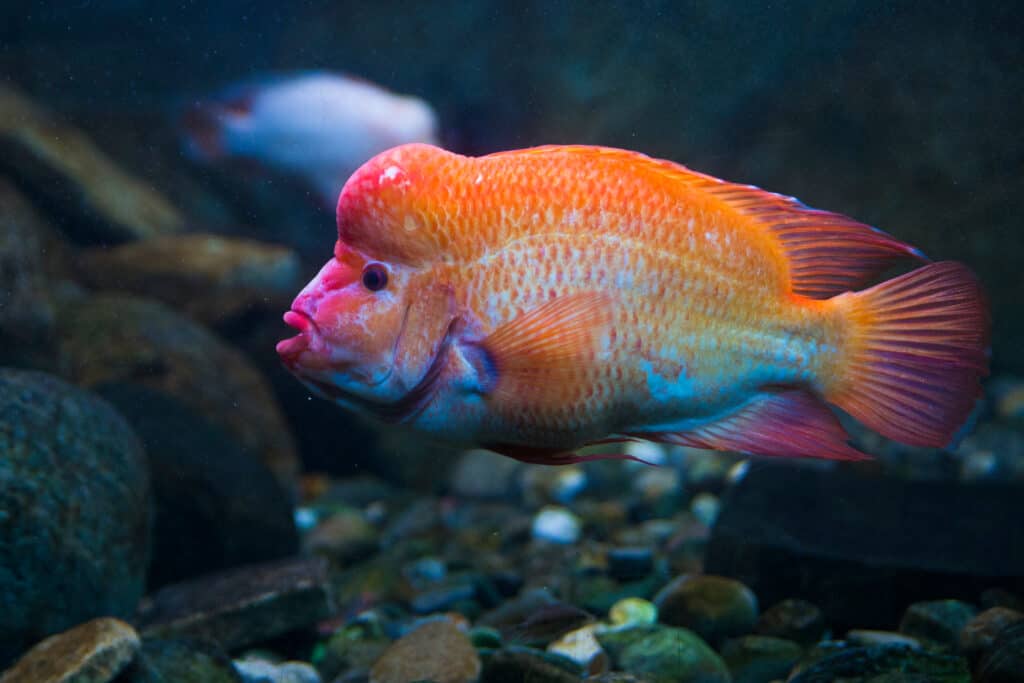
A red devil fish with its unique pronounced forehead.
©Mircea Costina/Shutterstock.com
Channel Catfish
The channel catfish are native to southern Canada and Northern Mexico but were introduced to Hawaii in the 1920s. Channel catfish are in the Nu’uanu and Wahiawa Reservoirs. Anglers favor them due to their high reproduction rate and hardy build.
You can tell a channel catfish by its distinctive scaleless body. It features a flat head, blue-grey to olive-brown color, and a deep forked tail. Some believe that the channel catfish is poisonous, but that’s not true! The fish’s spine, dorsal, and pectoral fins have mucus that can cause infections, but it’s not poisonous.

Channel catfish are almost ghostlike in looks.
©Ryan Somma, CC BY-SA 2.0, via Wikimedia Commons – License
Bluegill
Bluegill is another non-native fish that was introduced to freshwater ponds in Hawaii. The species can is in Kaua’i, O’ahu, and Maui. While anglers rarely catch bluegill, the species help feed largemouth bass.
A bluegill has a distinctive compressed body with dark olive-green to blue scales. In the sunlight, the scales also shine a blue or purple color. Other distinctive marks are black spots on their mouth and on their gills.

The bluegill has vivid scaling and a compressed body.
©Stacey Ann Alberts/Shutterstock.com
Largemouth and Smallmouth Bass
The smallmouth and largemouth bass were introduced to Hawaii in the early 1800s. However, they are around Kaua’i, O’ahu, and Hawaii. Large and smallmouth bass are popular for their mild yet fatty taste. In Hawaii, it’s popular to make grilled, pan-fried, and baked dishing featuring the fish.
Their scaling is greenish and olive-colored scaling. Aside from that, the species has an elongated body with a single continuous dorsal fin. The smallmouth bass is similar to the largemouth but is smaller in comparison. They also include bronze or brownish coloration, which differs slightly from the largemouth.
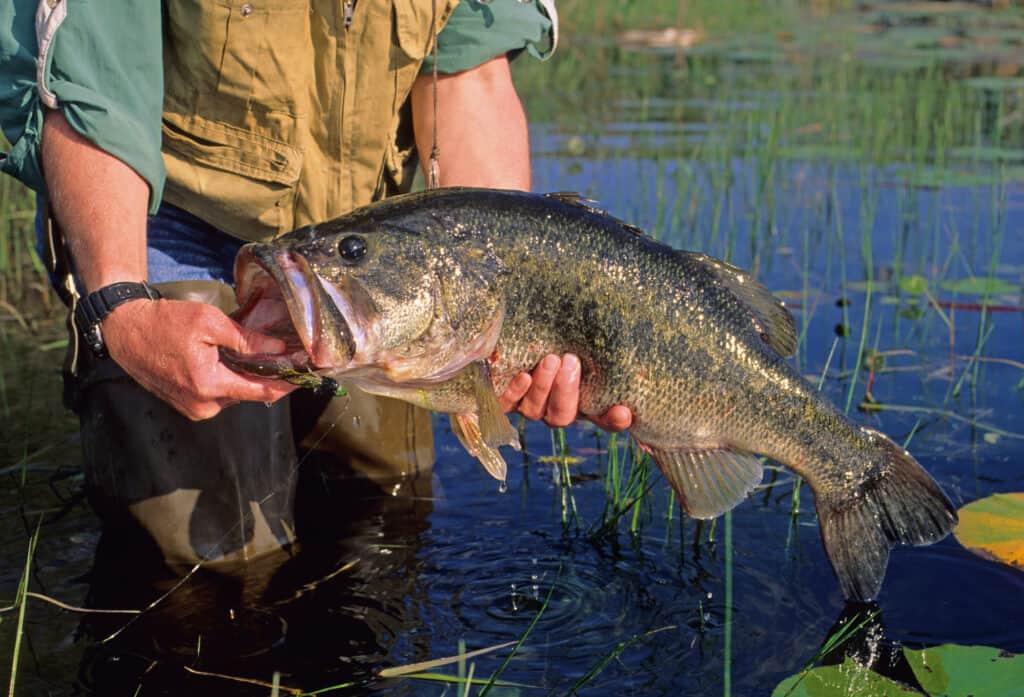
Largemouth bass are massive in size compared to other fish.
©iStock.com/stammphoto
Snakehead
Snakehead fish, also known as pongee, are non-native to Hawaii and were introduced in 1902 as a feeder fish for larger species. They are abundant in the O’ahu area and mostly reside in the Wahiawa Reservoir.
The species have a long cylindrical body with a large mouth and sharp teeth. Like snakes, their eyes are positioned upwards towards the top of their heads. They are extremely aggressive and come in a variety of colors and patterns.

The Snakehead fish has a similar body shape to a snake.
©bigjom jom/Shutterstock.com
Tilapia
Tilapia were introduced to Hawaii in 1957 as baitfish for larger fish. However, these fish are all over Hawaii in brackish water areas. They are abundant and are often the most sought-after fish for freshwater fishing in the state.
Tilapia has a distinctive compressed body with a pointed snout. The species in Hawaii have silver, grey, or brown scaling. The fish is easy to see even from the water due to their shimmering scales.
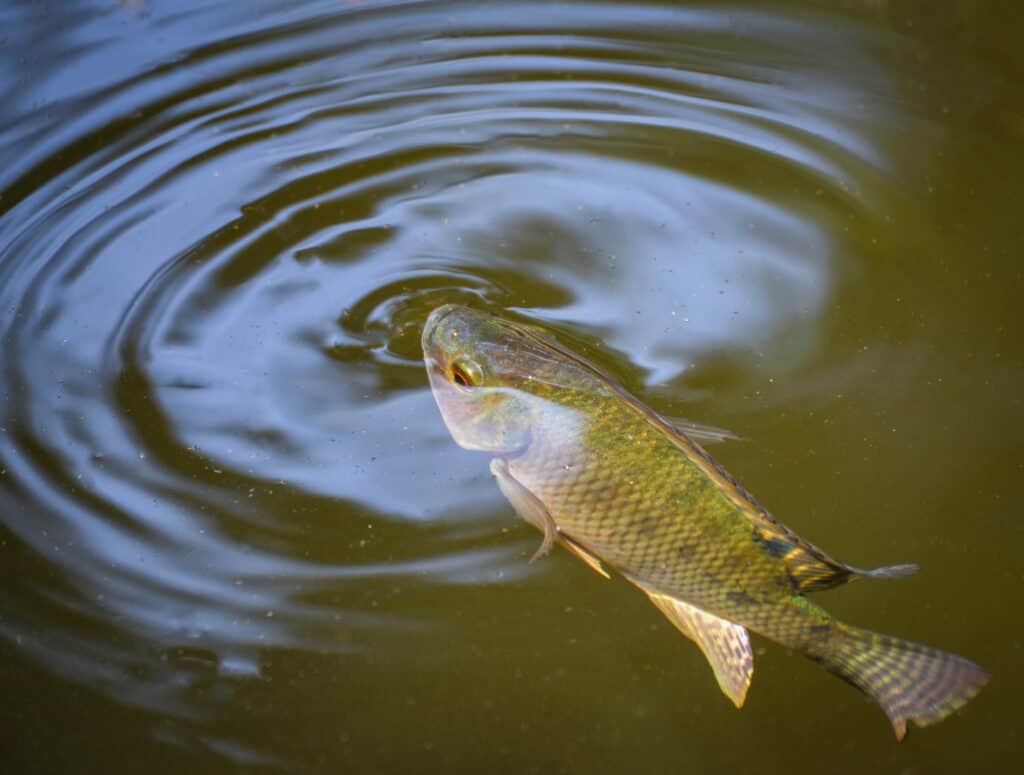
Tilapia are easy catches due to how abundant they are.
©iStock.com/panida wijitpanya
Fishing Limitations
Lake Wilson is the number one fishing spot with such a wide variety. However, it does have its limitations. Active fishing is only during certain times of the year. Consider the time of year if you’re looking for specific fish species. The main attraction for anglers is the peacock bass, but you can catch them between April and October.
Licensing
While the area is open to the public, only licensed fishermen by the Department of Land & Natural Resources, State of Hawaii, can fish. The permit required is the Wahiawa Public Fishing Area Entry Permit, which can be purchased online, in person, or from an authorized license agent. Those found trespassing will receive a fine.
Accommodations
Accommodations are a decent distance away from Lake Wilson. This includes guest houses, lodges, and inns. Most of the accommodations are located around 4 miles away from the lake. This makes it within perfect walking distance of the lake, where you can enjoy a full evening of freshwater fishing.
Just be careful when booking your stay. During prime fishing seasons, you can expect the hotels closest to Lake Wilson to have full reservations. So, make sure to make your arrangements a few months in advance.
3. Wailua Reservoir Public Fishing Area
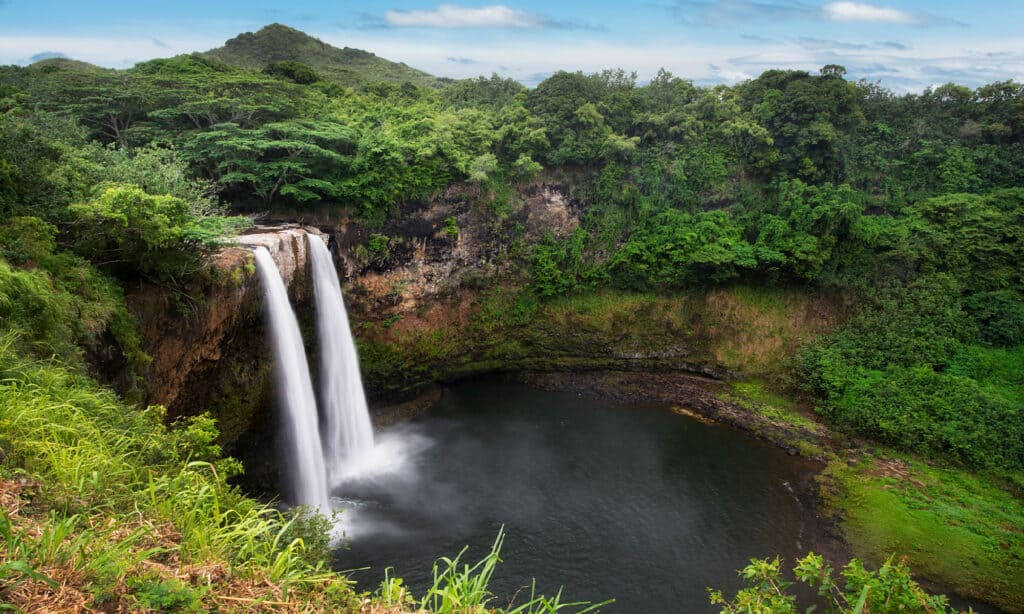
Wailua has many streams, lakes, and ponds full of freshwater fish.
©iStock.com/7Michael
The Wailua Reservoir is located off Kuamo’o Road and is home to the Wailua River. It’s a popular fishing area five miles from Wailua on Kauai Island. Here, you can find freshwater fish, some of which can only be found in this 5-acre pond above Wailua River State Park.
Wailua Fish Species
All of these fish are the same types in the Wahiawa Reservoir. In Wailua, you can find a few different types of fish, including:
- Largemouth Bass
- Smallmouth Bass
- Bluegill
- Tilapia
- Peacock
Fishing Limitations
Unlike other locations, there are specific bag and size limitations. This includes a bag limit of two seven inches long. In addition, they also have bag limitations based on the fish you catch. This includes:
- Smallmouth bass have a bag limit of 2 with a size of 9 inches.
- Largemouth bass have a bag limit of 2 with sizes 9 to 14 inches.
- Peacock bass have a bag limit of two with a size between 12-15 inches.
Licensing
Hawaii has strict laws when it comes to fishing, and to fish in the Wailua Reservoir, you will need a Freshwater Fishing Permit. You must have a permit if you want to fish in the public fishing areas. However, there are still limitations. You can get a permit online, in person, or from an authorized licensed agent.
Accommodations
Since the Wailua Reservoir is located in a state park, there are limited options for accommodations. You can find hotels sneed Wailua River State Park online, including hotels, rentals, and RV rentals. The Wailua River State Park does not have any camping accommodations. So, be sure to book your lodging before making a trip there.
4. Waiakea Pond

The Waiakea Pond is home to many freshwater and saltwater fish.
©iStock.com/ClaudineVM
Waiakea Pond is located near Hilo, Big Island, and is one of the best fishing lakes in Hawaii. Unlike other locations, Waiakea Pond is the largest natural lake located on Big Island. It features 25 acres of water, some being lakes and ponds. Unlike other locations, the Waiakea Pond has both freshwater and saltwater fish.
Waiakea Fish Species
Waiakea is home to freshwater and saltwater fish. This is due to the pond connecting with the ocean. Fish will swim upstream and nestle into freshwater areas if they can survive in those conditions.
Southern and Northern Puffer
The southern and northern pufferfish are native to Hawaii and are normally found in saltwater environments. Despite this, they sometimes move to freshwater environments, which is what happens in the Waiakea Pond. Both the Southern and Northern pufferfish contain poison in their viscera, which can be deadly if ingested. They are often not recommended for cooking unless done by a professional chef.
Pufferfish have a distinctive oval shape body that you can’t mistake for anything else. They have dark brown to black bodies with white spots. Aside from that, the Pufferfish has small eyes, a mouth, and small spikes, or tiny spines covering its body. When puffed up, the Pufferfish becomes extremely dangerous.
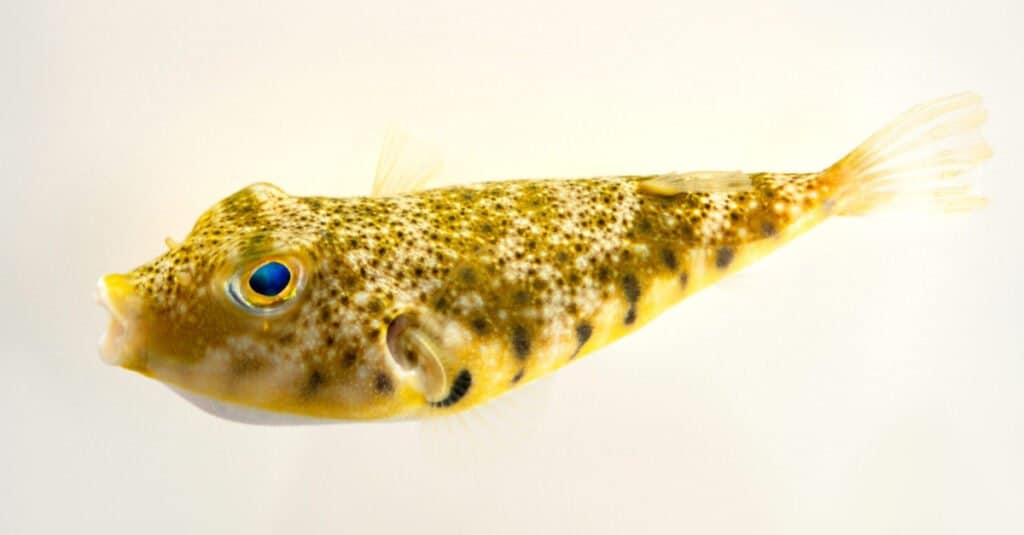
A northern pufferfish before it inflates.
©Animal Search/Shutterstock.com
Ulua
The ulua aukea, or giant trevally, is a native saltwater fish to Hawaii and can be found in Waiakea Pond. Anglers come to the area to find ulua due to its unique look and amazing taste when cooked. The ulua is one of the most well-known fish and is mentioned in Hawaiian songs, stories, etc.
Unlike other fish, the ulua has a massive body that is not only strong but fast. It has a deep, elongated shape and a broad head. Other distinctive features are a large mouth and razor-sharp teeth.
The ulua is an angler’s best catch, as they are a formidable foe when it comes to catching it. Some can grow to be 100 pounds and over 4 feet in length. Their strength, looks, and taste are highly sought-after in Hawaii.
Mullet
The mullet is a saltwater fish that migrates to freshwater as it ages. There are three types of mullet species in Hawaii, with two of them being native and one introduced. The native ones are the ‘ama’ama and the uouoa, and the kanda is non-native.
Mullets are silver or grey colored and have two dorsal fins with a small mouth. Generally, they can grow up to 9-19.5 inches and even have bluish or green strips on their sides.
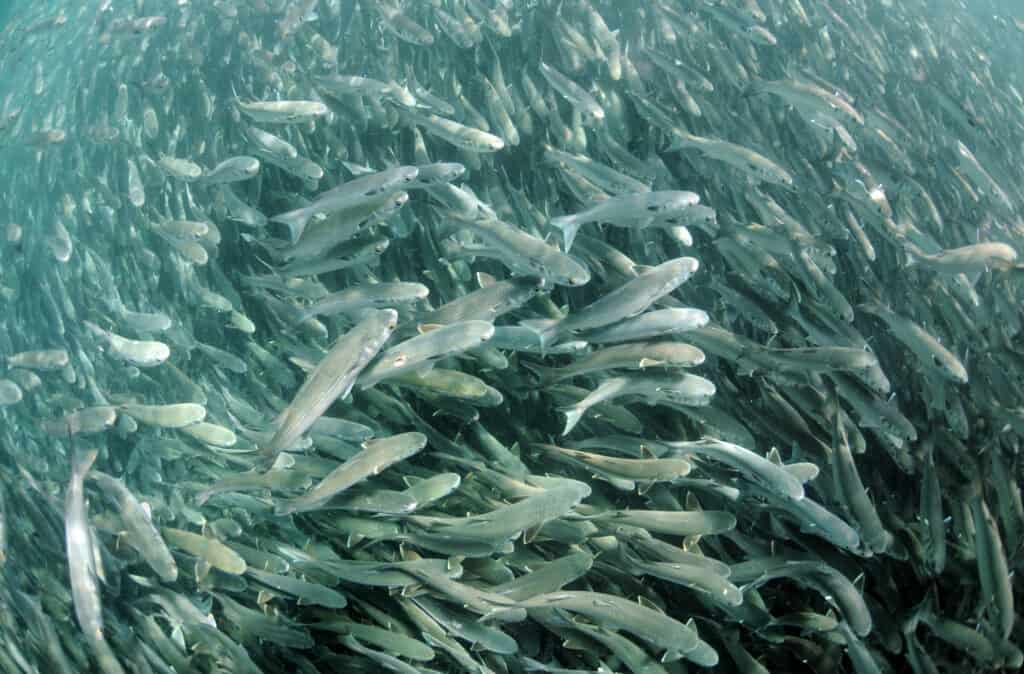
Their large schools and surface habits make mullet a favorite of game fishers.
©FtLaud/Shutterstock.com
Aholehole
The aholehole is a type of bass fish that lives in both salt and freshwater environments. The Hawaiian chain has them, and they are a popular fish to catch. Despite the fish’s appearance, it only spans around 12 inches.
The fish features a slender and elongated body that has a silver appearance. Its body also has hints of blue and grey and a silver hue. The most noticeable feature of the species is its forked tail fin, which makes it a quick swimmer. Anglers find it a challenge to catch.
Fishing Limitations
Fishing limitations apply to anyone wanting to fish at the Waiakea Pond. This includes a limit of 20 total fish per person. However, rules and regulations change constantly, and you will need to check locally to see what fish you can and can’t catch.
Licensing
All anglers must have a Freshwater Game Fishing License distributed by an accrediting source. The Department of Land and National Resources distributes the Freshwater Game Fishing License.
Accommodations
Waiakea is perfectly located near Hilo and the Hilo Airport. This makes it easy to travel to hotels, rentals, etc. You will need to book a reservation outside of the park, as the park does not allow camping.
The photo featured at the top of this post is © iStock.com/ClaudineVM
Thank you for reading! Have some feedback for us? Contact the AZ Animals editorial team.






